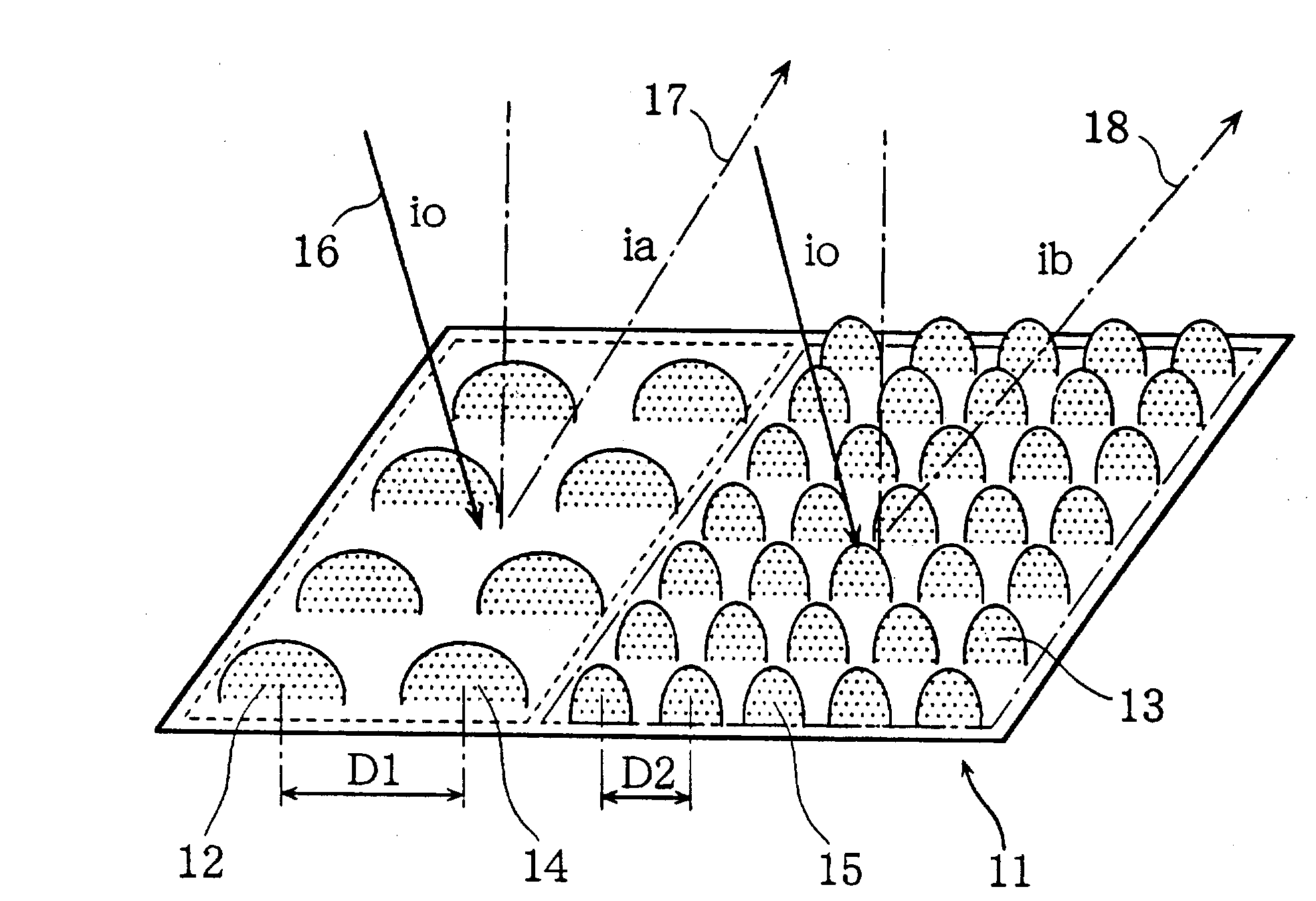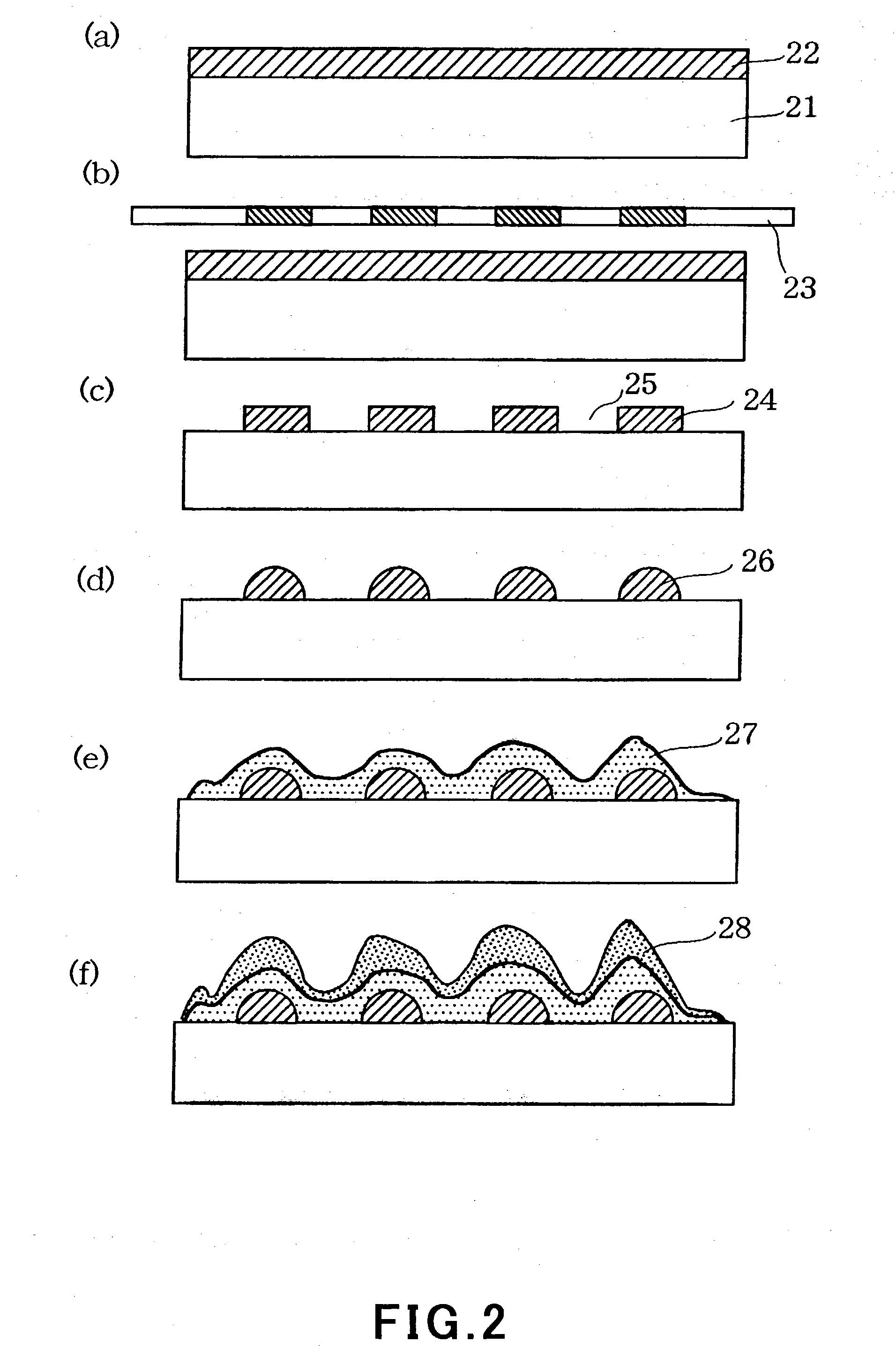Irregular-shape body, reflection sheet and relection-type liquid crystal display element, and production method and production device therefor
a liquid crystal display element and reflection sheet technology, applied in the field of irregular shape body, reflection sheet and relection-type liquid crystal display element, production method and production device therefor, can solve the problems of complex processes, significantly lower visibility, and no conventional technique to easily form a sloped surface of concave/convex shape into a generally triangle shap
- Summary
- Abstract
- Description
- Claims
- Application Information
AI Technical Summary
Problems solved by technology
Method used
Image
Examples
embodiment 1-1
[0123] (Embodiment 1-1)
[0124] The embodiment 1-1 is characterized in that a reflector has at least two or more regions formed thereon in which convex portions are arranged regularly or recurrently. This configuration provides an effect of making clouring be more invisible.
[0125] For the purpose of facilitating the understanding of the embodiment 1-1, a principle of the embodiment 1-1 is described prior to making description of a specific configuration of the embodiment 1-1.
[0126] [Description of Principle]
[0127] Adjacent convex portions or concave portions are formed so that they have recurrency, i.e., at a constant pitch, when concave / convex shapes are formed on a reflector. The pitch at this time is defined as d1 .mu.m. It is assumed that a white beam is directed to such a reflector at an angle of incidence of -i.sub.0.degree., relative to the axis on which the convex portions are formed, so that they have recurrency. It is observed so that a peak appears at a measured angle repre...
embodiment 1-2
[0147] (Embodiment 1-2)
[0148] FIG. 6 is a perspective view of the reflector according to the embodiment 1-2. A reflector 61 in this embodiment has two different regions, an A region 62 and a B region 63 that are formed thereon with the same pitches of the adjacent convex portions arranged in different directions. The convex portions 14 are formed on the surface of the reflector in the A region 62 at a pitch D1=9 .mu.m. A coordinate axis 64 shown in FIG. 6 is determined so that an angle 66 is 90.degree. between the axis and a straight line 65 corresponding to the direction of arrangement of the convex portions. On the other hand, an azimuth .theta.2 was 30.degree. in this embodiment. The B region has an arrangement corresponding to the arrangement of the convex portions of the A region rotated. Reflection characteristics of the reflector having the above-mentioned configuration were measured, while rotating the measurement device shown in FIG. 3 at right angles to the straight line 6...
embodiment 1-3
[0154] (Embodiment 1-3)
[0155] FIG. 9 is a perspective view of a reflector according to the embodiment 1-3. A reflector 91 that is used in this embodiment comprises convex portions arranged thereon so that recurrency is achieved for each pixel 92. More specifically, the reflector 91 has two different regions, an A region 93 and a B region 94 that are formed thereon with different pitches of the adjacent convex portions. Convex portions 95 formed on the A region 93 are arranged with a pitch D1 of 9 .mu.m between the adjacent convex portions. Convex portions 96 formed on the B region 94 are arranged with a pitch D2 of 7 .mu.m between the adjacent convex portions. The regions A and B are formed for each pixel.
[0156] For the reflector having the above-mentioned configurations, reflection characteristics were assessed, according to similar conditions to those used in the above-mentioned embodiment 1-1, on the reflector having such configurations using the measurement device shown in the a...
PUM
 Login to View More
Login to View More Abstract
Description
Claims
Application Information
 Login to View More
Login to View More - R&D
- Intellectual Property
- Life Sciences
- Materials
- Tech Scout
- Unparalleled Data Quality
- Higher Quality Content
- 60% Fewer Hallucinations
Browse by: Latest US Patents, China's latest patents, Technical Efficacy Thesaurus, Application Domain, Technology Topic, Popular Technical Reports.
© 2025 PatSnap. All rights reserved.Legal|Privacy policy|Modern Slavery Act Transparency Statement|Sitemap|About US| Contact US: help@patsnap.com



